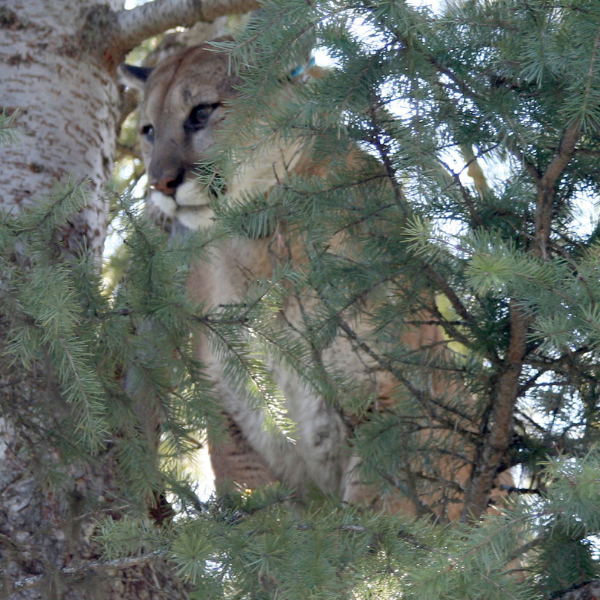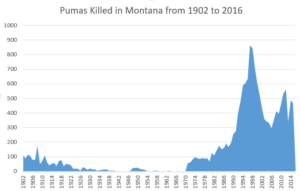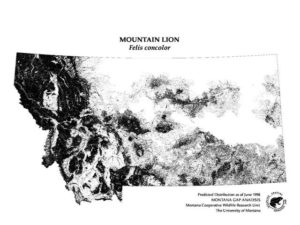In the Montana Code, Puma concolor is generally referred to as mountain lions.
Species Status
Lions are classified as large predators along with bears and wolves, and game animals along with deer, elk, moose, antelope, caribou, mountain sheep, mountain goats, bears, and wild buffalo. Laws pertaining to Montana’s endangered species do not apply to mountain lions because the law only covers nongame animals.
State Law
Generally, the Montana Code – the state’s collection of its laws – governs treatment of wildlife in the State of Montana. The state also collects its state agency regulations in the Administrative Rules of Montana. Since our summary below may not be completely up to date, you should be sure to review the most current law for the State of Montana.
You can check the statutes directly at their state-managed website. These statutes are searchable. Be sure to use the name “mountain lion” to accomplish your searches.
You may use Findlaw for Legal Professionals at this website.
The Legislature
The Montana State legislature is a part-time bicameral legislature. The lower chamber, the House of Representatives, consists of 100 members who are elected to two-year terms. The upper chamber, the Senate, consists of 50 members who serve four-year terms. The legislature meets for 90 days in odd-numbered years. Either the governor or a majority of legislators may call special sessions in order to deal with emergencies. However, the legislature has never succeeded in calling for a special session; the governor has called every special session in Montana history.
Montana Fish, Wildlife and Parks Commission
The Montana Fish, Wildlife and Parks Commission sets the Montana Fish, Wildlife and Parks Hunting Regulations. Along with mountain lions, the regulations contain provisions for the hunting of bison, black bear, deer, elk, antelope, furbearing animals, migratory game birds, moose, bighorn sheep, mountain goats, turkey, upland game birds, webless migratory birds, and wolves. Any regulations concerning mountain lions in captivity can be found under a subheading below.
Setting Regulations
The Montana Fish, Wildlife and Parks Commission is a five-member board appointed by the governor. The members serve staggered four-year terms with three members appointed at the beginning of the governor’s term and two members appointed two years later. There are no rules regarding its members’ political affiliations, but at least one member must have experience breeding and managing livestock. The commission sets the state’s fish and wildlife regulations, acquires property for the state, and approves Department of Fish, Wildlife and Parks rules.
Montana Fish, Wildlife and Parks
Montana Department of Fish, Wildlife and Parks (MFWP) enforces the state’s wildlife laws and the Fish, Wildlife and Parks Commission’s regulations. The department is part of the executive branch of the Montana state government. The department’s director reports directly to the governor.
Hunting Law
Hunting of mountain lions is allowed in the State of Montana. The regulations governing “recreational” hunting of mountain lions 146 hunting districts. Hound hunting is allowed.
MFWP allows the hunting of mountain lions with firearms and archery equipment. Montana has no rifle or handgun caliber limitation for mountain lion hunting. Archery equipment includes longbows, flatbows, recurve bows, compound bows, crossbows, and arrows. Archery only season is September 7 to October 20. Firearms are then allowed from October 26 to April 24.
Montana sets sex-specific quotas. Hunting districts are closed to the hunting of lions of that sex when the quota is met. The state’s regional wildlife managers set the quotas in consultation with local biologists.
Public Safety Law
Montana law states that there is no criminal penalty for killing a mountain lion that is “attacking, killing, or threatening to kill a person or livestock.” A person may also kill or attempt to kill a mountain lion that is attacking a domestic dog. The law does not mention what may be done if any animals other than dogs or livestock are attacked.
Depredation Law
Depredation law in Montana is by permit through the State’s Department of Fish, Wildlife and Parks. The law specifies that within two days of receiving word that game animals are damaging property, the MFWP will investigate the situation. The department will then open a special hunting season, destroy the damage-causing animal, or authorize the property’s owner to destroy the animal.
Owners of domestic animals are required to take certain steps to protect their pets or livestock, including paying a fee to cover the costs of enforcing livestock laws. There is also a government-funded compensation program for losses of domestic animals to mountain lions.
Trapping
Mountain lions may not be trapped for fur in Montana.
Poaching
Poaching law in the State of Montana provides some protection of mountain lions in law, but only as a deterrent. It is rare for penalties to be sufficiently harsh to keep poachers from poaching again.
For killing more than one mountain lion in a season, a hunter can be fined between $300 and $1,000, be imprisoned for up to 6 months, and have all their state hunting, fishing, and trapping privileges revoked for 2 years or a longer period imposed by the court. Hunting out of season can result in a fine between $50 and $1,000, imprisonment for up to 6 months, and the revocation of state hunting, fishing, and trapping privileges for a court-determined amount of time.
Road Mortalities
The Montana Department of Transportation does not keep records of mountain lions killed on the State’s roads.
Captivity
Mountain lions may be kept as pets according to Montana law regarding wild animals kept in captivity.





